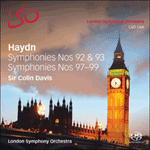
Welcome to Hyperion Records, a British classical label devoted to presenting high-quality recordings of music of all styles and from all periods from the twelfth century to the twenty-first.
Hyperion offers both CDs, and downloads in a number of formats. The site is also available in several languages.
Please use the dropdown buttons to set your preferred options, or use the checkbox to accept the defaults.

| London Symphony Orchestra, Sir Colin Davis (conductor)» More |
As in Symphony No 94, Haydn writes a theme-and-variation slow movement (here Adagio ma non troppo) that subjects an instantly appealing melody to dramatic transformations, most spectacularly in the third variation, where the violins create a whining, metallic sonority by playing sul ponticello (‘on the bridge’). Even more extraordinary is the coda, with its keening flute and oboe above faintly ominous string tremolos. Uniquely in these symphonies, the minuet and rustic-dance trio both have fully written-out repeats that present their themes in ever-new orchestral guises. The swaggering minuet subsequently becomes almost dainty; and the trio culminates in a delicious passage, like a transfigured village band, with a single violin (marked ‘Salomon solo ma piano’) playing the melody an octave above the orchestral violins. By 1792 Haydn’s London public were prepared for the élan and inspired theatricality of his sonata-rondo finales. No 97’s adds an aggressive brilliance and harmonic and contrapuntal dexterity of its own, climaxing in a coda that comically stutters to a halt before erupting in a final peal of C major.
from notes by Richard Wigmore © 2009
Comme dans la Symphonie no 94, Haydn écrit un mouvement lent en thème-et-variations (ici Adagio ma non troppo) qui soumet une mélodie d’emblée séduisante à de remarquables transformations, la plus spectaculaire survenant dans la troisième variation, quand les violons créent un son geignard, métallique, en jouant sul ponticello («au chevalet»). Plus extraordinaire encore est la coda, avec sa flûte et son hautbois ardents par-dessus des trémolos aux cordes vaguement inquiétants. Chose unique dans ces symphonies, le menuet et le trio de danse rustique ont des reprises écrites en toutes notes, qui présentent leurs thèmes sous des dehors orchestraux toujours neufs. De bravache, le menuet devient presque menu; quant au trio, il culmine en un délicieux passage, pareil à une fanfare villageoise transfigurée, avec un violon solo (marqué «Salomon solo ma piano») jouant la mélodie une octave plus haut que les violons orchestraux. En 1792, le public londonien était mûr pour l’élan et la théâtralité inspirée des finales en rondo-sonate haydniens. Celui de la no 97 a en plus pour lui un brillant agressif et une dextérité harmonico-contrapuntique qui lui sont propres: il culmine en une coda qui bredouille comiquement une pause avant d’exploser en un ultime éclat d’ut majeur.
extrait des notes rédigées par Richard Wigmore © 2009
Français: Hypérion
Wie in der Symphonie Nr. 94 schreibt Haydn einen langsamen Satz in der Form von Thema und Variationen (hier Adagio ma non troppo), das eine unmittelbar ansprechende Melodie dramatischen Transformationen unterwirft, besonders spektakulär in der dritten Variation, wo die Violinen durch sul ponticello (Spiel „auf dem Steg“) eine wimmernde, metallische Sonorität erzeugen. Noch außerordentlicher ist die Coda mit ihrer wehklagenden Flöte und Oboe über vage unheilschwangeren Streichertremolandi. Einzigartig in diesen Symphonien haben sowohl das Menuett als auch das Trio im Stil eines rustikalen Tanzes voll ausgeschriebene Wiederholungen, die ihre Themen in neuem Orchestergewand vorstellen. Das aufschneiderische Menuett wird später nahezu geziert, und das Trio kulminiert in einer köstlichen Passage in der Manier einer verwandelten Dorfkappelle, in der eine einzige Violine („Salomon solo ma piano“ markiert) die Melodie eine Oktave über den Violinen des Orchesters spielt. 1792 war das Publikum längst auf den Schwung und die inspirierte theatralische Manier seiner Sonatenrondo-Finales vorbereitet. Das in Nr. 97 fügt aggressive Brillanz und seine eigene harmonische und kontrapunktische Gewandtheit hinzu, die sich in eine Coda steigern, die komisch stolpernd zum Einhalt gerät, bevor sie in ein abschließendes schallendes C-Dur ausbricht.
aus dem Begleittext von Richard Wigmore © 2009
Deutsch: Renate Wendel
 Haydn: Symphonies Nos 92-3 & 97-9 Haydn: Symphonies Nos 92-3 & 97-9Sir Colin Davis was long recognized as a pre-eminent Haydn interpreter. During his Indian summer with the orchestra he recorded both 'The Creation' and 'The Seasons' for LSO Live. The symphonies presented here were recorded in 2011 during this sam ...» More |

